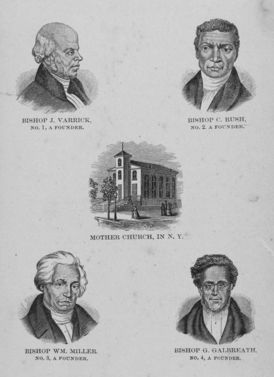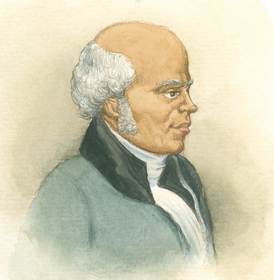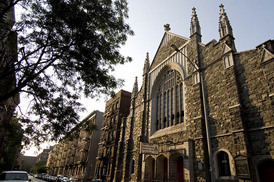Mother AME Zion Church
In the late 1700s, the Methodists of the mostly white John Street Church welcomed Africans and their descendents, and many came to worship there. Peter Williams, born a slave, became a sexton and James Varick became a deacon of the church. In time, however, the worshipers in the Negro pews grew frustrated. They wanted to speak out against slavery and to worship as equals. Finally, in 1796, James Varick led a group of about 100 worshipers to an old rented building on Cross Street to worship separately. This congregation would found the Mother African Methodist Episcopal Zion Church, the first black church in the state.
By 1800, the group moved into a small wooden building at the corner of Church and Leonard Streets. The church thrived, and by 1820, Mother Zion had a new brick building. That same year the leaders voted to leave the White Methodist Episcopal Church because it would not ordain black bishops. James Varick became the first Bishop of the new church. It was a time when more and more black New Yorkers were gaining their freedom. These newly free African Americans were determined to end slavery in the South and racism in the North. The AME Church played a big part in the activism of that time. It was a stop on the Underground Railroad and many who worshiped there, such as Frederick Douglass and Sojourner Truth, became leaders and abolitionists.
As African Americans moved uptown, so did the church. Today Mother AME Zion Church is located at 140-7 W. 137th Street in Harlem.
This entry contributed by
Curriculum Concepts International
Related Media
Video

|
Public Historian Cynthia R. Copeland talks about what motivated the Mother African Methodist Episcopal Zion Church to move uptown to Seneca Village in the 1820s.
|
Images

|
The present Mother AME Zion Church is located at 140-7 W. 137th Street. The building was designed by George W. Foster, Jr., one of the first black architects to be licensed in the U.S.
|

|
An illustration of church founders and bishops depicts Bishop J. Varrick, No.1, A founder; Bishop C. Rush, No.2, a Founder, Mother Church, in N. Y.; Bishop Wm. Miller, No.3, a Founder; and Bishop G. Galbreath, No.4, a Founder.
|

|
The first black church in the state was the Mother AME Zion Church located at 158 Church Street. James Varick was its first bishop.
|

|
This portrait of James Varick, first Bishop of the African Methodist Episcopal Zion Church, was published to commemorate 100 years since the church was founded.
|








